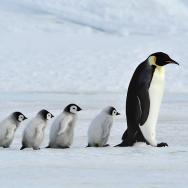One might assume that birds of flight are cosmopolitan travelers, and bird species should be distributed far and wide—spread across long distances and even continents. However, a study led a former University of Chicago graduate student shows that birds have strong ties to the climate patterns of their habitat. As a result, the geographical distribution of birds may be more restricted than we think.
Scrutinize the distribution of birds across the globe, and it is obvious that land birds, for example, have ranges that abruptly end at coastlines. You may not notice a similar turnover of bird species within continents, but in fact one is present at the freezing line—the boundary between the tropics and cooler, temperate areas.
As part of his PhD thesis at UChicago, Alex White, PhD’18, conducted a study that shows that despite no significant physical barriers stopping them from spreading out, bird species are strongly confined to their habitats as demarcated by the freezing line. The results were recently published in the journal Nature Communications.
Nowhere in the world does the freezing line loom as drastically as the Himalayas. But it is not the world’s tallest mountain peaks that serve as the boundaries of avian habitats and movement; instead, it is the freezing line, which cuts across the slopes at an elevation of about 1600 meters—less than a fifth of the way up to Mount Everest’s peak.
White worked with adviser Trevor Price, professor of ecology and evolution at UChicago, to examine 305 species of open-habitat and tree-dwelling birds out of the known 621 species present in the Himalayas. The numbers of species were estimated over a ten-year period from reported sightings and vocalizations across 38 sites in the Himalayan forests.
The researchers analyzed their field data by developing what's called a grade of membership model. In this model, bird species were assigned to a few groups based on their geographical patterns of coexistence. Then, the model can help determine if a particular location predominantly consists of one group, or a mixture. It’s a bird distribution equivalent of ancestry genetic testing services such as 23andMe and Ancestry.com. These companies associate a client’s DNA profile to a country of origin, and White’s grade of membership model links bird observations to geographical origin and climate across the Himalayas.
Not exactly as free as a bird
The model allows for the possibility that each bird group be from multiple geographical areas, but it still showed little mixing of groups across the tropical-temperate divide. Moreover, the researchers discovered that bird groups within the same climate zones also have the same evolutionary roots. This means that climate has had a long history in shaping population distributions.
“The abundances of birds that cross the freezing line seem to change according to whether or not their region of origin was the temperate or tropics,” said White, now at National Museum of Natural History in Washington, D.C. “This is surprising because the freezing line in the Himalayas—the sharpest in the world due to the extremely steep elevation gradients—spans only tens of kilometers. Our results highlight the importance of climatic barriers to bird population distributions.”
Temperate regions are not freezing all year round, only during the winter season. So why aren’t Himalayan birds distributed more uniformly across the freezing line, especially during the warmer breeding months? The answer may lie in the flora of a bird’s habitat.
Unlike birds, plants have very particular adaptations to freezing, and birds rely closely on the plants in their habitat. Birds are picky eaters, consuming locally specific foods, such as insects associated with the vegetation in their home.
“Our study demonstrates that bird distributions are strongly connected to a given environment, and the freezing line is really the underlying component that's changing the habitats,” White said. “Birds may just be overlaid on to their habitats.”
In the future, White wants to study the impact of climate on the distribution of ecological attributes of birds such as beak shape, using the same model. For now, this study points to how one of the environment drives the distribution of bird populations across the globe.
“Our results show that bird communities are contained by much more discrete boundaries than maybe we had previously appreciated,” White said. “The movement of these discrete boundaries could have serious implications for the functioning of the ecosystem, leading to instabilities if we alter the environment that birds rely on.
“One thing to note,” he added, “the climatic patterns in this study evolved under a regime of change that was much less extreme than climate change that exists now.”
Additional authors on the research included Matthew Stephens, professor of human genetics and statistics at UChicago; Kushal Dey, a graduate student in the Stephens lab; and Dhananjai Mohan from the Wildlife Institute of India.
Citation: “Regional influences on community structure across the tropical-temperate divide” Nature Communications. June 14, 2019. Doi: 10.1038/s41467-019-10253-6
—Article originally appeared on the University of Chicago Medicine website.

